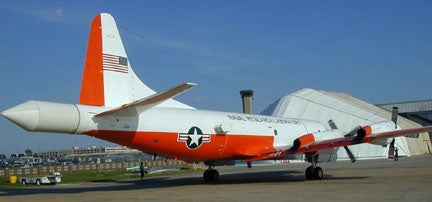ELectra DOppler RAdar (ELDORA)
- Contents

PLEASE NOTE THAT ELDORA IS NO LONGER AVAILABLE FOR DEPLOYMENT
ELDORA data are available in the EOL Field Data Archive.
Description
ELDORA is an airborne, dual beam, meteorological research radar developed jointly by NCAR and France's Centre de Recherches en Physique de L'Environnement Terrestre et Planetaire (CRPE), France. ELDORA's first deployment was to TOGA COARE in the Solomon Islands in January and February 1993.
ELDORA-s mobility allows observations of clouds, convective systems and storms over remote regions.
ELDORA mounts on a Lockheed P-3 aircraft, operated by the Naval Research Lab (NRL). Its two antennas extend back from the tail of the aircraft and spin about the longitudinal axis of the aircraft. One antenna points slightly ahead of the aircraft and one slightly aft. As the aircraft translates the antennas through space ELDORA traces two conical helixes through the atmosphere, essentially observing all of the atmosphere with two separate looks within 50-100 kilometers of the aircraft.
The fore and aft looks from ELDORA yield two wind components for each location in the atmosphere. Applying the conservation of momentum and mass, a 3-dimensional structure of the atmosphere is produced which can then be sliced through any axis to produce two dimensional plots.
The ELDORA radar system consists of five major functional blocks: the RF signal generator/receiver unit, the TWT high power amplifiers, the signal processor, the antenna/rotodome system, and the radar control equipment. Since the radar system consists of two separate fore- and aft- pointing radars much of the hardware contains two identical modules. Only the basic signal generation equipment and the radar control equipment do not contain duplicate modules.
The research flight speed of the P-3 aircraft is approximately 130 m/s. At this flight speed the scientific requirement for samples every 300-500 m dictates an antenna rotation rate of approximately 24 RPM. This resolution also dictates at least one integration period (dwell time) to be completed every degree of rotation which gives dwell times the order of 8 msec. Since the phenomena to be studied has a time to independence of 3-7 msec., only two or three independent samples can be taken in a dwell time with a simple radar pulse. To meet the velocity accuracy of 1 m/s requires about 10 independent samples. A complex waveform is therefore necessary.
The waveform chosen was a 4-element stepped chirp. Physically, a complex waveform consists of a pulse of RF energy, within which are sub-pulses or chips which are coded in some way. For ELDORA these chips are distinguished by discrete shifts in transmit frequency which enable the received signals to be processed individually, thus improving the sampling statistics of the radar measurements. The resulting transmitted waveform consists of these composite pulses. The frequencies must be close enough together that the unambiguous velocity and the beam squint angle for each frequency are similar but far enough to maintain required independence. A typical frequency separation is 10 MHz.
At X-band and typical PRFs the unambiguous velocity is relatively small and the velocity data are frequently folded. ELDORA has solved this problem by operating in dual PRT mode. The two PRTs have a ratio of 4/5 and extend the Nyquist velocity to 110 m/s.

The ELDORA output variables include radar reflectivity, mean radial velocity, spectral width, and normalized coherrent power. These data are passed to the data recording and display system, thus enabling the data system to receive all data from both the fore and the aft radars, to tag it with aircraft position information and to record and display the data.
| ELDORA Specifications | |
| Number of Radars | 2 (fore and aft) |
| Wavelength | 3.2 cm |
| Transmit Frequency | 9.3 - 9.8 GHz |
| Beamwidth (circular) | 1.8o |
| Antenna gain | 3.7 dB |
| Polarization (00 elevation) | horizontal |
| First Sidelobe Power | -35 dB |
| Beam Tilt Angle (fore and aft) | +- 15 - 19o |
| Antenna Rotation Rate | 5 - 144 o/s |
| Dwell Time | 7 - 50 ms |
| Rotation Sampling Rate | 0.75 - 2.00o |
| Peak Transmitted Power | 35 - 40 kw |
| Receiver Bandwidth | 1.5 - 4.0 MHz |
| Receiver Temperature (at antenna) | < 600o K |
| Pulse Repetition Frequency | 2000 - 5000 Hz |
| Minimum Detectable Signal (at 10km) | -12 dBZ |
| Unambiguous Range | 20 - 90 km |
| Unambiguous Velocity (single PRT) | +-13 - 20 m/s |
| Unambiguous Velocity (dual PRT) | +- 80 - 110 m/s |
| Number of Frequencies | 4 |
| Pulse Chip Length | 0.25 - 3.00 us |
| Range Averaging | 1-4 gates |
| Total Cell Length | 37.5 - 1200 m |
| Along Track Sweep Spacing | 0.3 - 1.0 km |
Contacts
Science: Dr. Wen-chau Lee / wenchau@ucar.edu / (303) 497-8814
Data: eol-datahelp@ucar.edu
https://www.eol.ucar.edu/observing_facilities/electra-doppler-radar-eldora